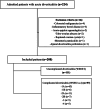Prospective analysis of adiposity metrics for complicated acute colonic diverticulitis: Should WSES Classification and visceral adiposity be integrated for predictive analyses?
- PMID: 40387926
- PMCID: PMC12089201
- DOI: 10.1007/s00068-025-02884-w
Prospective analysis of adiposity metrics for complicated acute colonic diverticulitis: Should WSES Classification and visceral adiposity be integrated for predictive analyses?
Abstract
Background: Colonic diverticulitis is correlated with age, body mass index (BMI), and increased visceral or subcutaneous fat. Obesity contributes to diverticulosis, diverticulitis and its complications onset, as visceral fat activates inflammatory pathways that exacerbate these conditions. The aim of this study was to evaluate the association of visceral adiposity and BMI on complications of acute colonic diverticulitis.
Method: A prospective cohort study was conducted on patients with acute diverticulitis admitted to the general surgery ward of a university hospital in Istanbul from September 2017 to February 2022. A total of 208 patients were classified into uncomplicated and complicated diverticulitis per the World Society of Emergency Surgery guidelines. After documenting demographic, clinical, and laboratory data, along with BMI and computed tomography measurements of visceral and subcutaneous fat areas (VFA, SFA), we conducted a statistical analysis to assess the relationships between VFA, SFA, and BMI in both groups.
Results: Complicated diverticulitis group was found to have significantly lower values of BMI and VFA (p = 0.037 and p = 0.046 respectively). Similarly, BMI and VFA values of patients who underwent all interventional procedures including percutaneous drainage and surgery were found to be significantly lower than the conservative treatment group (p = 0.007, p = 0.025 respectively). V/S < 0.68 is an independent predictor in the complicated group.
Conclusion: Our study shows that complicated diverticulitis cases have lower BMI and visceral fat area. We suggest that increased visceral adipose tissue may serve a protective role by preventing these diverticula from developing into more complicated forms. Therefore, visceral adiposity metrics can be integrated in the predictive analyses.
Keywords: Body mass index; Complicated diverticulitis; Obesity; Visceral adiposity; WSES.
© 2025. The Author(s).
Conflict of interest statement
Declarations. Ethics approval: The study was approved by the Istanbul Medeniyet University, Goztepe Prof. Dr. Suleyman Yalcin City Hospital’s Ethics Committee with the approval number 2021/0223. Consent: Written informed consent was obtained from participants prior to the study. Competing interests: The authors declare no competing interests.
Figures



Similar articles
-
Visceral adiposity and inflammatory bowel disease.Int J Colorectal Dis. 2021 Nov;36(11):2305-2319. doi: 10.1007/s00384-021-03968-w. Epub 2021 Jun 9. Int J Colorectal Dis. 2021. PMID: 34104989 Review.
-
The role of quantitative radiological measures of visceral adiposity in diverticulitis.Surg Endosc. 2021 Feb;35(2):636-643. doi: 10.1007/s00464-020-07427-5. Epub 2020 Feb 18. Surg Endosc. 2021. PMID: 32072285
-
The relationship between colonic diverticulosis and abdominal visceral and subcutaneous fat accumulation measured by abdominal CT scan.Turk J Gastroenterol. 2014 Apr;25(2):192-7. doi: 10.5152/tjg.2014.4581. Turk J Gastroenterol. 2014. PMID: 25003681
-
Visceral to subcutaneous fat ratio predicts acuity of diverticulitis.Surg Endosc. 2017 Jul;31(7):2808-2812. doi: 10.1007/s00464-016-5290-2. Epub 2016 Oct 24. Surg Endosc. 2017. PMID: 27778168
-
2020 update of the WSES guidelines for the management of acute colonic diverticulitis in the emergency setting.World J Emerg Surg. 2020 May 7;15(1):32. doi: 10.1186/s13017-020-00313-4. World J Emerg Surg. 2020. PMID: 32381121 Free PMC article. Review.
References
MeSH terms
LinkOut - more resources
Full Text Sources

